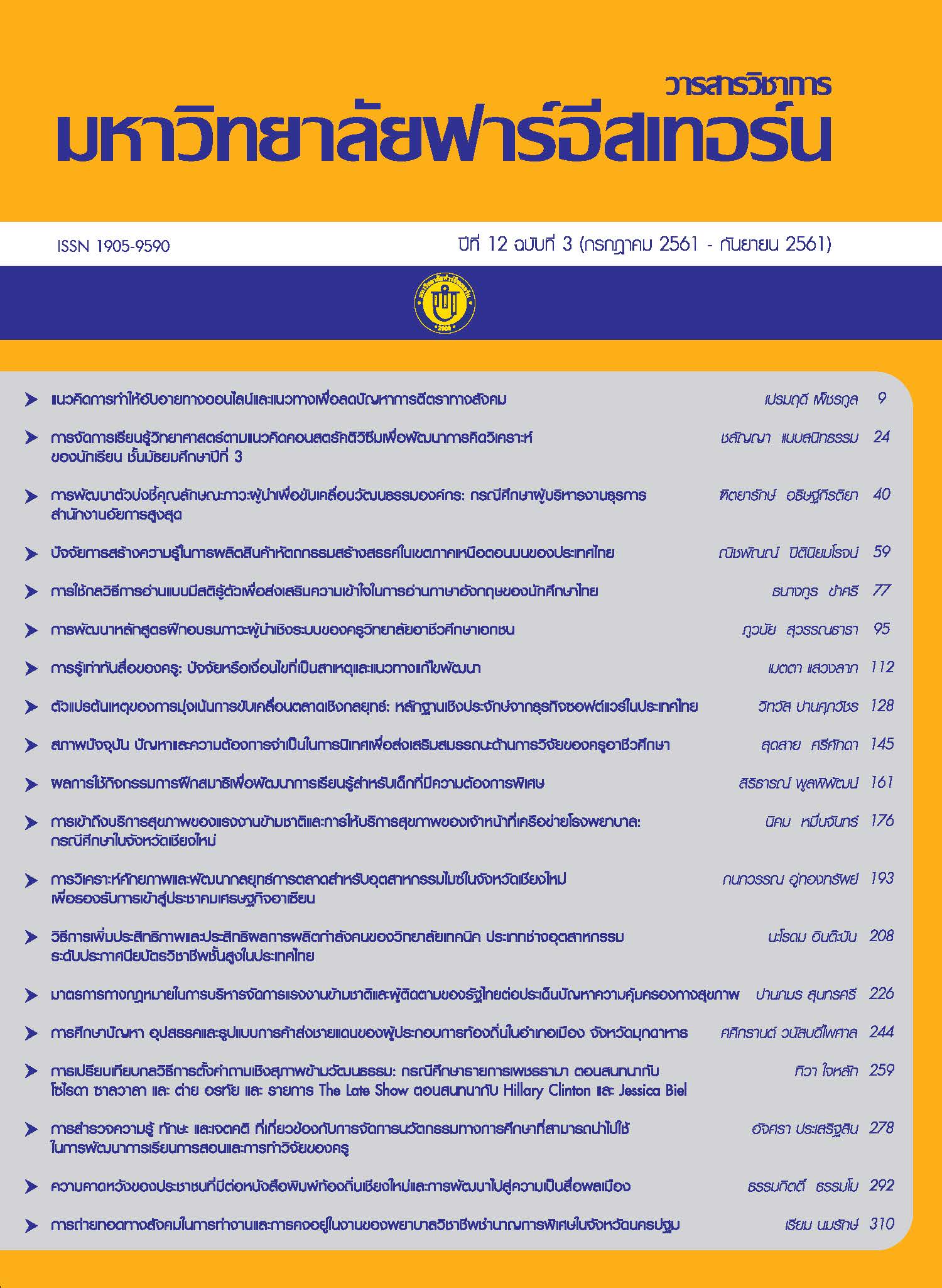Knowledge Creation Factors that Affecting the Production of Creative Handicrafts in The Upper Northern Thailand
Main Article Content
Abstract
การวิจัยครั้งนี้มีวัตถุประสงค์ 1) เพื่อศึกษาความสัมพันธ์ระหว่างปัจจัยการสร้างความรู้ที่ส่งผลต่อการผลิตสินค้าหัตถกรรมสร้างสรรค์ในเขตภาคเหนือตอนบนของประเทศไทย 2) เพื่อพัฒนาโมเดลการสร้างความรู้ในการผลิตสินค้าหัตถกรรมสร้างสรรค์ในเขตภาคเหนือตอนบนของประเทศไทย กลุ่มตัวอย่างที่ใช้ในการวิจัยครั้งนี้ ได้แก่ ผู้ประกอบการจำนวน 235 ราย ที่เป็นสมาชิกของศูนย์สร้างสรรค์งานออกแบบ เชียงใหม่ หรือ สมาคมผู้ผลิตและส่งออกสินค้าหัตถกรรมภาคเหนือ หรือ สำนักงานส่งเสริมการค้าระหว่างประเทศภาคเหนือ จังหวัดเชียงใหม่ เครื่องมือที่ใช้ในการวิจัย เป็นแบบสอบถาม และการสังเกตจากการสัมภาษณ์ สถิติที่ใช้ในการวิเคราะห์ข้อมูล ได้แก่ สถิติแบบพรรณนา การวิเคราะห์ค่าสัมประสิทธิ์สหสัมพันธ์ และการถดถอยพหุคูณ (Multiple Regression Analysis) ผลการวิจัยแบ่งออกเป็น 3 มิติ ดังนี้ มิตินวัตกรรม: ปัจจัยการสกัดความรู้ และ สิ่งแวดล้อมในการทำงาน มีความสัมพันธ์อย่างมีนัยสำคัญต่อผลลัพธ์การผลิตสินค้าหัตถกรรมสร้างสรรค์เมื่อวัดจากจำนวนของนวัตกรรมใหม่ มิติความรู้ใหม่: พบว่าปัจจัย การสกัดความรู้และ การแลกเปลี่ยนเรียนรู้ มีความสัมพันธ์อย่างมีนัยสำคัญกับผลลัพธ์การผลิตสินค้าหัตถกรรมสร้างสรรค์ เมื่อวัดจากจำนวนของสินค้าที่ผลิตโดยใช้ความรู้ใหม่ ส่วนมิติสินค้าสร้างสรรค์ : พบว่า ปัจจัย การสกัดความรู้ และการแลกเปลี่ยนเรียนรู้ มีความสัมพันธ์อย่างมีนัยสำคัญกับผลลัพธ์การผลิตสินค้าหัตถกรรมสร้างสรรค์ วัดจากจำนวนของการได้รับรางวัลหัตถกรรมสร้างสรรค์
ดังนั้นจากผลการวิจัยทั้งสามมิติที่กล่าวมาข้างต้น อาจสรุปได้ว่า ปัจจัยการสร้างความรู้ที่มีความสัมพันธ์ต่อการผลิตสินค้าหัตถกรรมสร้างสรรค์ ได้แก่ปัจจัย การแลกเปลี่ยนเรียนรู้ (SOC), การสกัดความรู้ (EXT) และสิ่งแวดล้อมในการทำงาน (Envir) โดยทั้งสามตัวแปรส่งผลต่อตัวแปรตามในทางบวก และมีทิศทางเดียวกัน ซึ่งหมายความว่า เมื่อเพิ่มการดำเนินการในกิจกรรมที่เกี่ยวข้องกับปัจจัยทั้งสามตัวนั้น ก็จะทำผลผลิตเชิงสร้างสรรค์มีแนวโน้มเพิ่มขึ้นตามไปด้วย
The objectives of this research were 1) To study the relationship between knowledge creation factors and the production of creative handicrafts in upper northern Thailand. 2) To develop knowledge creation model for the production of creative handicrafts in upper northern Thailand. Research samples of this research were 235 entrepreneurs who are the member of Chiangmai’s Thailand Creative and Design Center, Northern Handicrafts Manufacturers And Exporters Association, and Chiangmai’s International Trade Promotion Center. Data collection tools of this research were questionnaires, observations, and in-depth interviews. The analysis was done by using descriptive statistics, correlation, and multiple regressions. The results indicate that on the innovation dimension, externalization (making usable explicit knowledge) and working environment causally affect the production of creative handicraft products measured by numbers of innovation. On new knowledge dimension, externalization and socialization (knowledge sharing among workers) affect the production of creative handicrafts measured by numbers of products that were created by new knowledge. On creative product dimension, this research also found that externalization and socialization both affect the production of creative craft products measured by numbers of creative handicraft rewards received by the firms. The overall conclusion from the results above is that knowledge creation factors that positively affect the production of creative handicrafts are socialization, externalization, and working environment. This implies that the increase in the operation of all three factors will increase new knowledge and ultimately increase creative outputs.
Article Details
1. Any views and comments in the Journal of Social Innovation and Lifelong Learning are the authors’ views. The editorial staff have not to agree with those views and it is not considered as the editorial’s responsibility.
2. The responsibility of content and draft check of each article belongs to each author. In case, there is any lawsuit about copyright infringement. It is considered as the authors’ sole responsibility.
3. The article copyright belonging to the authors and The Far Eastern University are copyrighted legally. Republication must be received direct permission from the authors and The Far Eastern University in written form.

